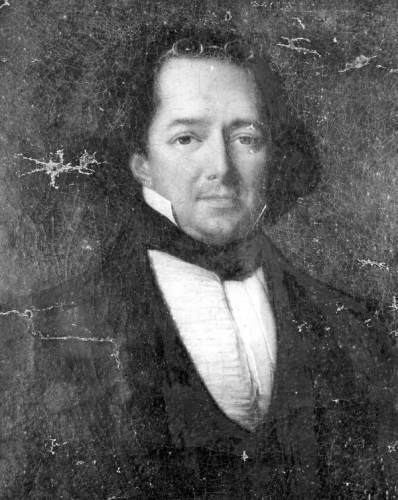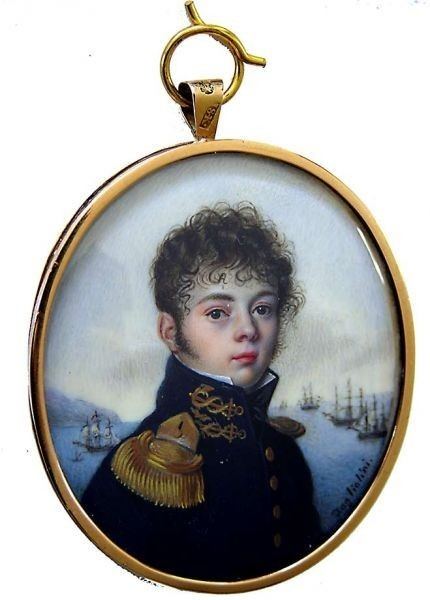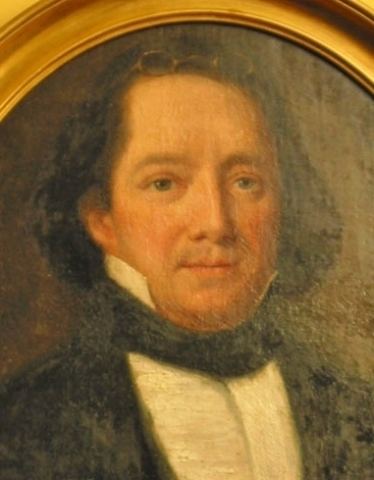Predecessor Prince Joachim Name Prince Murat Mother Caroline Bonaparte | Father Joachim Murat Successor Prince Lucien | |
 | ||
Tenure 13 October 1815 – 15 April 1847 Born 21 January 1801 ( 1801-01-21 ) Died April 15, 1847, Tallahassee, Florida, United States Spouse Catherine Willis Gray (m. 1826) Books The United States of North America Parents Joachim Murat, Caroline Bonaparte Cousins Napoleon III, Napoleon II, Eugene de Beauharnais, Napoleon Louis Bonaparte, Charles Leon Similar People Joachim Murat, Caroline Bonaparte, Lucien Murat, Catherine Willis Gray, Letizia Ramolino | ||
Maison du prince achille murat
Charles Louis Napoleon Achille Murat (known as Achille, 21 January 1801 – 15 April 1847) was the eldest son of Joachim Murat, the brother-in-law of Napoleon who was appointed King of Naples during the First French Empire. After his father was deposed and executed by his own subjects, Achille Murat went into exile in Austria with his siblings and mother.
Contents
- Maison du prince achille murat
- Early life
- Exile in Austria and emigration to the United States
- On the Florida frontier
- Friendship with Ralph Waldo Emerson
- To Europe and back
- References

At the age of 21, Achille Murat emigrated to the United States and settled at St. Augustine, Florida, becoming a naturalized citizen sometime after July 1828 and dropping his European titles.

Early life

Achille Murat was born in the Hôtel de Brienne in Paris, France. His father was Joachim Murat, the son of an affluent farmer and innkeeper, who became one of Napoleon's loyal band. Joachim Murat was appointed Marshal of France for his military service, and was later awarded royal positions by Napoleon under the First French Empire, including the throne of the Kingdom of Naples.

Achille's mother was Caroline Bonaparte, sister of Napoleon. She was styled Grand Duchess of Berg and Queen of Naples, while Achille was considered a prince.
Murat's governess was Catherine Davies from Anglesey in Wales. In 1841 she published a memoir describing her eleven years' service with the Murat family.
Exile in Austria and emigration to the United States
After Napoleon was exiled for a second time in 1815, Joachim Murat was deposed and executed by his subjects. Young Achille and his siblings were taken by their mother into exile at the castle of Frohsdorf, near Vienna in Lower Austria. When Murat turned twenty-one, he obtained permission to emigrate to America.
In 1821 he embarked from a Spanish port bound for the United States. On arrival in New York, Murat immediately applied for naturalization. After a few months in that city he made an extensive tour through the United States, using an assumed name at first. He had a striking resemblance to his famous uncle in countenance and mannerisms. Although he had renounced all his European titles and citizenship, his wide social connections brought Murat to Washington, where he befriended Richard Keith Call, Florida's territorial delegate to the Congress.
On the Florida frontier
Call told Murat of opportunities in the new territory of Florida, which had been acquired by the United States from Spain in 1821. In the spring of 1824, the former "Prince of Naples" settled in St. Augustine, reputedly renting what is now called the Prince Murat House on St. George Street. Murat soon became active in St. Augustine society by joining the Masonic lodge and dabbling in local politics. He enrolled in the local militia and was briefly a volunteer under the command of his personal friend, Brigadier General Joseph Hernandez.
Murat purchased an extensive property of 2,800 acres (1133 ha) and built a plantation where he planted orange groves, sugar cane, cotton, and tobacco. He named it 'Parthenope', in honor of his onetime principality in Naples, Italy, which had been founded on the site of the ancient Greek colonizers' settlement of Parthenope (see History of Naples).
Murat's Parthenope was located about ten miles south of St. Augustine on the west side of the Matanzas River, at the mouth of Moses Creek. Murat liked to go nude and made a submersible chair to escape the heat of the north Florida summers, using it to sit naked in the waters of Moses Creek with mosquito netting over his head. A neighbor observed that he was obsessed with the "...eatibility of the whole animal tribe." Murat was known to have experimented with eating baked turkey buzzard, boiled owl, roasted crow, stewed alligator, lizards and rattlesnakes. He had an aversion to baths, didn't like to change his clothes, "washed his feet only after he wore out his shoes," and slept on a mattress stuffed with Spanish moss.
Around 1825, Murat bought the land he would call Lipona Plantation, 15 miles (24 km) east of Tallahassee. He lived there during the remainder of Florida's territorial and early statehood days. The name Lipona is an anagram of "Napoli" (Naples), the kingdom where Murat once thought he would succeed his father. He purchased Lipona at the prodding of the Marquis de Lafayette, beneficiary of the Lafayette Land Grant of July 4, 1825, which had granted him (LaFayette) 36 square miles (93 km2) of land near what would become the city of Tallahassee.
Many authors have fallen victim to the claims that Murat was once an elected Alderman of the City of Tallahassee in 1824, Mayor in 1825, and then Tallahassee's longest-serving Postmaster (1826-1838). All of these claims are completely false and disproven by the public record and contemporary sources. The origins of these claims seems to be an 1890s tourism "guide book" published by the Murat estate (e.g. Bellevue Plantation) that wildly overstated the political life of Prince Murat; the guide book is mentioned in Bradford Torrey's 1895 book entitled 'A Florida Sketch-Book' which recalls Torrey's 1893 visit to the Murat estate in Tallahassee. Torrey wrote that Catherine Murat's neighbor and another local 'indisputable citizen' - a judge - completely refuted the Murat claims published in the tourist's guide-book. One should also note the original City Charter for the City of Tallahassee was not in effect until Dec 9, 1825 and the first municipal election was not held until Jan. 2, 1826. With this information, it is clear there was no city council in existence in 1824 or 1825 to be alderman or mayor of. Furthermore, Federal records clearly show Isham G. Searcy as the Federally-appointed Postmaster of Tallahassee for the period claimed in the Murat estate guide-book.
Legend tells that the Marquis' agents arranged for a group of fifty or sixty Norman French farmers to settle on the land around 1831, but there is no documentation of this taking place. In 1824, Murat was elected alderman of the city, and mayor in the following year. In 1826 he was appointed United States postmaster, which office he held till 1838.
Murat met Catherine Daingerfield Willis Gray in 1826 and married her on July 12 of that year at Tallahassee, Florida. They did not have any children. Gray was the great-grandniece of George Washington.
Murat's political sympathies seem to have been Jacksonian throughout his time in Florida. At a political rally in 1826, he called one of the candidates, his neighbor David Betton Macomb, a "turncoat"; Macomb had led a toast to Kentucky statesman Henry Clay on at least one occasion that summer (an alternative version of the story has Macomb upset that Murat's slaves were stealing his hogs). Macomb and Murat met at a local dueling ground near Hiamones Lake. Murat’s shot went through Macomb’s shirt without touching flesh, and Macomb’s took off half of the little finger of Murat’s right hand.
During the early phase of the Seminole Wars, and for the previous three years, Murat was a lieutenant colonel of Florida’s militia and sometime aide to Brigadier General Richard Keith Call. He would retain the rank of colonel the rest of his life.
Friendship with Ralph Waldo Emerson
In the winter of 1826, during one of his periodic visits to St. Augustine, Murat met the American writer Ralph Waldo Emerson. The two became close friends and enjoyed discussing topics of the day as well as politics, society, and history. Of Murat, Emerson wrote:
A new event is added to the quiet history of my life. I have connected myself by friendship to a man ... with as ardent a love of truth as that which animates me, with a mind that surpasses mine in the variety of its research, & sharpened & strengthened to an energy for action to which I have no pretension by advantages of birth & practical connection with mankind beyond almost all men in the world.Like his contemporary, Alexis de Tocqueville, Murat was one of the first notable essayists on culture and mores in the new republic of the United States. During his residence at his plantation near St. Augustine, Murat began to write his observations on American politics and his daily life in Florida in fluent French, Italian and English. He wrote on slavery, economics, and literature as well, but his books never caught on with the public. Murat was a staunch defender of slavery although he professed to fight for human liberty.
To Europe and back
Following the July Revolution of 1830 in France, Murat returned to Europe, where he was assigned to the command of a regiment of the Belgian Legion. While in Belgium and France, he hoped to regain some part of the family fortune based on the properties of his parents. His attempts were futile, and in 1834 the Murats returned to the Tallahassee area.
In 1835, Murat and his wife moved to Louisiana, where he had purchased a sugar cane plantation outside New Orleans and a town house in the city. The couple lived there for several years while he practiced law without much success.
After their return to Florida, Murat mortgaged the Lipona property to the Tallahassee Union Bank. He lost it in 1839 when he could no longer meet his financial obligations as a result of the delayed effects of the financial recession of 1837. He and his wife were forced to move to a smaller plantation they named Econchatti, in present-day Jefferson County, Florida. Murat died there in 1847, and was buried in the St. John's Episcopal Church cemetery in Tallahassee.
His maternal first cousin, Napoleon III of France, provided his widow with a cash sum of $40,000 and an annual stipend so that she could live the life to which she had become accustomed. She proved to be a better handler of money than her husband had been, and purchased the Bellevue plantation in 1854. She held court among her friends and admirers until after the Civil War. Catherine Murat died in 1867 and was also buried at the St. Johns Episcopal Church cemetery. In 1967, the Bellevue plantation house was moved to Tallahassee, where it has been made part of the Tallahassee Museum.
